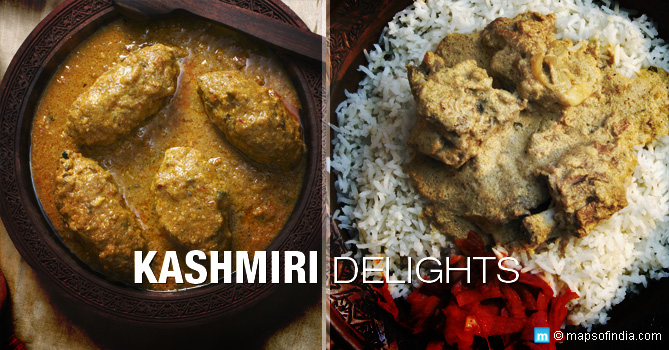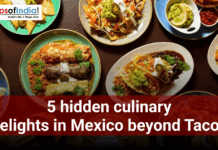 Kashmir, which is also called heaven on earth for its spectacular scenic beauty, is also a haven for the most sumptuous gastronomic delights. Be it the Kahwah (a green tea flavoured with cinnamon stick and saffron), the kadam saag or the wazwan, the cuisine of Kashmir is based on ancient traditions and has its own unique stamp. This cuisine is also prevalent amongst the Kashmiri diaspora living in Pakistan.
Kashmir, which is also called heaven on earth for its spectacular scenic beauty, is also a haven for the most sumptuous gastronomic delights. Be it the Kahwah (a green tea flavoured with cinnamon stick and saffron), the kadam saag or the wazwan, the cuisine of Kashmir is based on ancient traditions and has its own unique stamp. This cuisine is also prevalent amongst the Kashmiri diaspora living in Pakistan.
The Spices & Ingredients Used
Kashmiri cuisine is renowned for the gracious use of spices to spruce up a dish, and with a distinctive flavour of its own because of influence of Central Asia, Persia, China, and the Indian subcontinent. As with all regional food in India, the ingredients include the local produce. The following is a comprehensive list of ingredients that feature in Kashmiri cuisine:
- The dishes are flavoured with cinnamon, cardamom, cloves, poppy seeds and fennel seeds giving them a special taste and a spectacular aroma.
- The Kashmiri chilli, mild and yet full of flavour and colour is another core ingredient.
- The stem of the lotus flower – abundant in the lakes and other water bodies of Kashmir – is eaten in a variety of preparations.
- Black mushrooms found on the mountains, and the flowers and leaves of pumpkin are also used.
- Pampore, the “Saffron Town of Kashmir’ produces one of the best quality saffron, second to Spain, and thus saffron finds a key role in most of the dishes of Kashmir.
- With a wealth of dry fruits like walnuts and almonds available in the region, these also are used in ample quantities, especially in the preparation of gravy.
- Unlike the Mughlai cuisine, garlic and onion are not used much.
- Kashmiri food makes an extensive use of turmeric and yoghurt.
- A unique ingredient used at the time of winter is dehydrated vegetables. Kashmir is snow clad during winters. In the summer months some key vegetables like tomatoes, brinjal, turnips and zucchini etc are dried in the sun and stored. In the winter months, when vegetables are not available, these are immersed in hot water and used in dishes.
The Science
Kashmir faces the harshest of winters and unfortunately most of its farmlands are unused because of intense terrorist activities. These reasons have contributed to more of non-vegetarianism in the region. Even the Brahmins of the region are meat eaters. The weather has also contributed towards using rich ingredients and spices to provide for inner warmth.
The Gastronomic Delights
The Kashmiri cuisine is highly influenced by the Kashmiri Pandits and has more of a non-vegetarian fair. Kashmiri Rice also forms an integral part of the cuisine, balancing the rich and spicy flavours of the dishes. The meal includes a combination of vegetarian and non-vegetarian dishes. Some of the famous dishes are Dum Alu, Tomato chutney, Kadam Saag, and Waza Palak.
Bakery items of Kashmir are also mouth watering and will get one’s gastric juices flowing. Some of them are:
- Patties and pastries
- ‘Sheermal’ and ‘baqerkhani’ are integral part of Kashmiri breakfast.
- Tsot and tsochvoru, small roundbreads, topped with poppy and sesame seeds.
- Lavas, a cream coloured unleavened bread
- Baqerkhani, a puff pastry
- Kulcha, a short bread, sweet or savoury, topped with poppy seeds.
Wazwan
The most famous of all the dishes of Kashmir feature in the Wazwan, a multi-course meal in the Kashmiri Muslim tradition. There are 36 courses in the entire traditional meal and the process of cooking wazwan is an art in itself. The course mostly includes mutton or chicken. A traditional Wazwan features the following
- Service begins with rice along with Seekh Kebab and Methi Korma (chicken or lamb spices with dried fenugreek leaves)
- This is followed by tabak maaz (twice-cooked lamb ribs, initially braised with ground spices and milk, then browned in butter), safed kokur (chicken with white sauce), zafran kokur (chicken with saffron sauce).
- Yogurt and chutney are served separately.
- Nearly 20 other items follow the aforesaid dishes and include:
o Rista (meatballs in red sauce)
o Rogan josh (mutton in red gravy)
o Daniwal korma (lamb roasted with yoghurt and spices)
o Aab gosh (lamb chunks cooked with a fennel-based spice mixture)
o Marchhwangan korma (chicken legs/thighs cooked in a spicy browned-onion sauce)
o Gushtaba (meatballs cooked in a spicy yoghurt gravy). The meal ends with the Gushtaba.
o The Vegetarian dishes in the wazwan include Yakh’n (delicately spiced yogurt curry), Ruwangan Chhaman (cheese squares with Tomato gravy), Dum Aelva (potatoes cooked in yogurt gravy), Muji Chetintin (a sharp radish and walnut chutney)
o The sweet served is Phirni ( a milk based sweet with crushed rice).
The meals are consumed by hand from a vessel called traem, a copper platter and washed down with the local beverage called kahvah, a green tea spiced with cinnamon and spices.
The Kashmiri food is indeed rich and redolent with the flavour of the local spices. Dating back to 1500s when Taimur invaded India, this cuisine has the best of the both sides of the great Himalayas.




